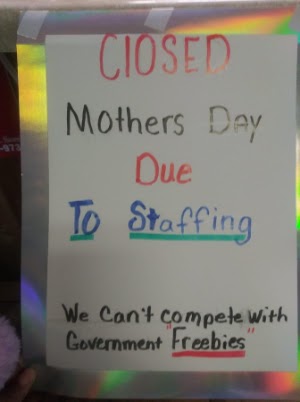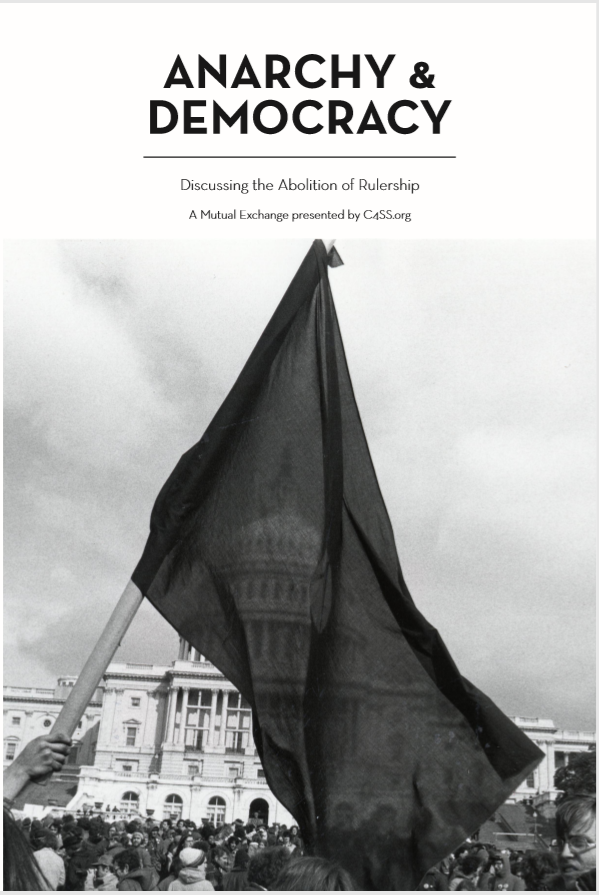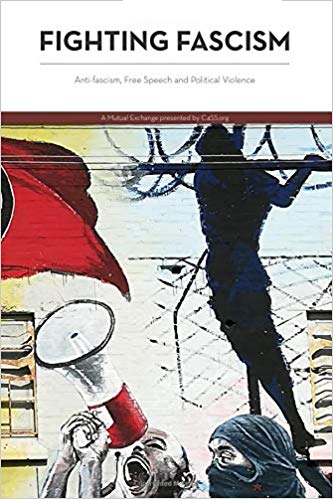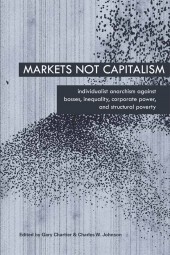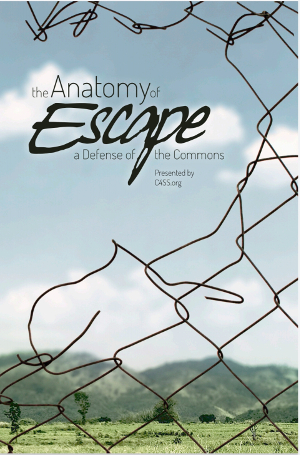De Jason Lee Byas. Título original: Melting Mountains of Ice, de 14 de abril 2021. Traducido al español por Kathiana Thomas.
Una Doctrina de No-Gobierno para el Siglo 21
En la actualidad, casi todos aceptan al menos una idea utópica: que la esclavitud es tan inaceptable desde la moral que esta práctica debe ser erradicada allí donde se encuentre, y cualquier institución que dependa de ella debe demolerse inmediatamente.
Es probable que sea incluso un eufemismo el decir que las personas aceptan esa idea. Es el núcleo mismo del sentido común moral; si cualquier otra idea parece que, en determinadas circunstancias, podría implicar algo distinto, esa idea queda descartada.
Pero como he dicho, es una idea utópica. En el mundo antiguo, había algunas personas que pensaban algo así —como el estoico Dion Crisóstomo o el primer obispo cristiano Gregorio de Nisa—, pero eran pocos y distantes. Incluso cuando llegamos a mediados del siglo XIX, en vísperas de la abolición, William Lloyd Garrison estuvo a punto de ser alquitranado y emplumado en Boston por promoverla.
Garrison y otros como él representaron el flanco radical al rechazar que alguna persona pueda llegar a poseer otra. Entonces, no es sorprende que pudieras a menudo escuchar algunas otras ideas utópicas al hablar con los abolicionistas. Tal como los apologistas de la esclavitud gustaban de recordar a las personas, Garrison también sostuvo una «doctrina de no-gobierno».
Él se encontraba sólo entre los abolicionistas en dicha doctrina. Junto a las denuncias de esclavitud y exhortaciones para abolirla a través de la insurrección, Lysander Spooner componía proclamas anarquistas proponiendo anular todas las legislaturas y tribunales estatales en favor de un sistema legal que no diera cabida al monopolio de la autoridad.
A medida que nos acercamos a los doscientos años desde que Garrison estuvo a poco de ser alquitranado y emplumado, la victoria sobre la esclavitud está más que consolidada; sin embargo, la doctrina del no-gobierno sigue pareciendo una causa sin remedio tal como lo fue para aquel entonces.
Son estas batallas aparentemente irremediables las cuales este libro busca pelear: En contra de la clase protegida de pandillas con poder de monopolio, el uso del asesinato o encierro como sistema de responsabilidad, un apartheid internacional entre los que nacen bajo distintos mandatarios, y juegos globales de poder derribando peones humanos.
Esto es lo que tenemos en mente cuando hablamos de la abolición a día de hoy. Tal como Garrison y Spooner lo miraron, la abolición que está por venir es una extensión de la abolición ya realizada.
La doctrina del no-gobierno supone un inconveniente para el resto de marcos referenciales políticos, ya que este apunta hacia las funciones centrales de cualquier Estado: conservador, nacionalista, progresista, socialista, e incluso, liberal clásico.
Incluso para aquellos que todavía se aferran a dichos marcos, es fácil ver la emoción de encontrar un mundo puesto de cabeza y proponerte el enderezarlo. La tremenda enormidad de la tarea puede ser una fuente de energía, tal como con la famosa exclamación de Garrison de que se encontraba «en llamas», teniendo «montañas de hielo que derretir».
¿Importa Si Otro Mundo Es Posible?
Al mismo tiempo, encontrarse en llamas puede llevar a quemarse (o desgastarse).
Algunos de quienes aceptan las ideas del anarquismo en lo abstracto, que es correcto «en la teoría ideal», o incluso que las instituciones que rechaza son innecesarias, siguen teniendo un problema diferente con él.
Los Estados a día de hoy, o al menos muchos de ellos, no simplemente son los Estados del mundo premoderno. Estos son instituciones extractivas; pero esta extracción es constitucionalmente limitada. Estas rigen sobre nosotros; no obstante, este dominio a menudo va de la mano de concesiones que benefician las vidas reales de personas reales.
Sí, la extracción constitucionalmente limitada continúa siendo extracción, y las concesiones que recibimos no son nada comparadas al mundo que podríamos tener sin ellas. Seguro, dice este detractor. Pero, prosigue, esto pierde de vista su punto.
Los Estados han sido contenidos y reentrenados con un éxito no-trivial, y nosotros sabemos que esto puede funcionar hasta cierto punto ya que hemos visto esto ocurrir. Las bandas pueden utilizar libremente la cabeza decapitada del Presidente en la portada de un álbum, el Estado enseñará matemática y ciencia a tu hijo durante cinco días a la semana sin costo adicional; cada cuatro de noviembre, si suficientes personas no quieren que el presidente sea presidente más, ese Presidente solo deja de ser Presidente. Debe admitirse que todo esto es bastante increíble en el gran esquema de las cosas.
Si son muchas las personas circulando a alta velocidad por tu vecindario y poniendo en peligro a tu familia, ciertamente es posible que puedas realizar acciones directas e instalar badenes por tu cuenta. Pero también podría ir a una reunión del ayuntamiento.
En resumen, incluso si la doctrina del no gobierno tiene respuestas adecuadas para «¿Es lo correcto?» y «¿Puede funcionar?», algunos pueden seguir preguntándose «¿Por qué molestarse?».
La tentación de añadir un «¿y qué importa?» a la doctrina del no-gobierno recae en los anarquistas experimentados, tanto en su calidad de teóricos de la política como de agentes del cambio político. ¿Por qué entrar en sus extrañas opiniones sobre cómo podríamos despenalizar el crimen y hacerlo todo a través de la responsabilidad civil —¡a través de agencias de arbitraje competentes, nada menos!— cuando puedes limitarte a hablar de lo obviamente injusto que es el decomiso de bienes civiles? ¿Qué propósito práctico tiene esa salvaje creencia de fondo cuando puedes simplemente hacer banca telefónica para el candidato a gobernador que pasó treinta años como abogado defensor?
Es en contra de esta tentación de pensamiento y acción en la que quiero invertir el resto de esta introducción. Es una tentación de complacencia, pero es una tentación que, sin embargo, merece una respuesta.
Mantener el Fuego Encendido
En resumen, hay tres razones básicas para molestarse: estar alerta, permanecer fieles, y estar preparados.
Estar alerta
En nuestro mundo estructurado alrededor del Estado, es fácil perderse al tratar preguntas tangenciales como fundacionales.
Es probablemente cierto que hubo mejores y peores reclamos a alguna corona, o que algunos teóricos de la sucesión real fueron más consistentes que otros. Sin embargo, toda la tinta derramada en estas preguntas ha desaparecido en mayor medida de la memoria colectiva.
No recordamos de ninguna manera los debates intra-monarquistas tan bien como lo hacemos con las primeras defensas de la democracia representativa. Esto no se debe a que estos últimos fueran intrínsecamente más sofisticados, sino a que los primeros trataban sobre cuestiones contingentes cuyo tiempo ha pasado. Al insistir en cuestiones básicas sobre lo que hace que un orden político sea legítimo en primer lugar, son los teóricos democráticos los que se han quedado con nosotros.
Partiendo de la base de que la democracia liberal podría no ser el fin de la historia —una suposición compartida por alguien que está de acuerdo en que el anarquismo es correcto, y puede funcionar, pero que sólo se pregunta por qué debería molestarse—, hurgar en las cuestiones de la teoría democrática hoy corre el riesgo de acabar como los monarquistas de ayer.
Elaborar los mejores y más consistentes principios para un Estado democrático liberal es ciertamente suficiente trabajo para una vida. Sin embargo, esa vida se pasaría yendo y viniendo por un laberinto sin salida al final, buscando la forma adecuada de un acuerdo que no puede hacerse verdaderamente justo.
Además, el exceso de familiaridad con ese laberinto puede llevarte a olvidar que sus paredes son paredes. Los ajustes parciales de las teorías «para una sociedad básicamente justa como la nuestra» pueden no dar nunca la respuesta que se busca, cuando esa respuesta existe más allá de esos muros.
Teorizar la política como teorizar los gobiernos significará a menudo tratar los fundamentos básicos de un gobierno como una caja negra, tanto normativa como positivamente. Se perderán o minimizarán las fuentes de orden social que provienen de fuera del Estado, y se perderán o minimizarán los elementos de justicia con los que el Estado es incompatible.
Cualquier doctrina de no-gobierno va a ser un no-comienzo para muchas conversaciones políticas de hoy en día, con la premisa de guiar la acción del estado. Pero la relevancia en las conversaciones de hoy es la relevancia dentro de las conversaciones que son en sí mismas irrelevantes en un sentido más ulterior. El mundo es el campo abierto más allá del laberinto de preguntas y respuestas internas del Estado democrático liberal.
También una posición complaciente encarcela la acción política práctica. Si tratas los canales electorales como los verdaderos canales de cambio, seguirás corriendo en esa rueda de hámster para siempre.
Por ejemplo: Si devuelves el libre flujo de ideas a lo que dicen las leyes del Estado sobre el libre flujo de ideas, te centrarás en intentar persuadir a los tribunales y a las legislaturas para que flexibilicen la propiedad intelectual. Esto no ha tenido éxito.
En cambio, si se tiene firmemente en cuenta que el flujo real de ideas no tiene ninguna relación necesaria con lo que las leyes del Estado dicen al respecto, estarás alerta. Las oportunidades de hacer que la propiedad intelectual sea inaplicable mediante el intercambio de archivos serán visibles para ti, y podrá aprovecharlas. Esto ha demostrado ser muy exitoso.
Este punto se generaliza: Por ejemplo, la preocupación por la autodefensa y la capacidad de armarse en consecuencia, filtrada a través del marco centrado en el Estado se convierte en un grupo de presión. Esto, en la práctica, significa la financiación de organizaciones cuya misión se centra más en los mensajes culturales populistas de derechas que en la derogación de las restricciones a las armas. Sin la venda estadocéntrica, simplemente se puede asegurar el acceso a las armas haciendo que sean más fáciles de construir en casa.
Si te preocupas por el anarquismo, te mantienes alerta a las cuestiones de importancia duradera, y alerta a los medios reales de promover la causa de la libertad.
Permanecer fieles
Por supuesto, lo peor para los defensores del viejo orden no se trata de que sus contribuciones se hayan vuelto irrelevantes. Es la mancha moral del sistema que defendieron: El robo flagrante de la propiedad campesina, las masacres sin más propósito que la expansión y la tortura pública contra quienes lo desafiaban.
No sólo eso, sino que muchos de los horrores debieron serlo en sus propios términos. Los defensores del derecho divino se aferraban a una religión de poner la otra mejilla y bendecir a los pacificadores, pero se encontraron apoyando el derecho de los principados y potencias a quemar vivos a los disidentes.
La analogía aquí resulta evidente: aquellos quienes proponen la libertad individual y se conforman con el Estado liberal democrático también se conforman con instituciones que de manera segura hacen criminales de personas pacíficas. Quienes se conforman con dicho sistema, junto a la justicia social como su convicción permanente, se conforman con un sistema que sin lugar a dudas redistribuye la riqueza hacia arriba.
Quienes aceptan el anarquismo en lo abstracto, pero optan por ajustar el Estado liberal democrático, se resistirán a esta descripción, y tienen razones claras para hacerlo. Ellos no apoyan el hecho de que el Estado liberal democrático crea criminales de personas pacíficas, ni tampoco que en todo caso redistribuya la riqueza hacia arriba. De hecho, su proyecto es aplastantemente el reducir y revertir los procesos por los cuales las personas pacíficas son convertidas en criminales y la riqueza sea redistribuida hacia arriba.
Aquí de nuevo, sin embargo, conviene mirar al presente a la luz del pasado.
La defensa de Aristóteles a la «esclavitud natural» es una parte incómoda de su Política. Lo que potencialmente se pierde en nuestra incomodidad es que Aristóteles rechazaba la esclavización de alguien quien no entrara dentro de sus estipulaciones de «esclavitud natural», y, por lo tanto, podemos ver estos pasajes como un intento de reformar y restringir la institución.
Independientemente de las intenciones de Aristóteles, nosotros generalmente no recordamos que su defensa de la esclavitud fue más limitada que las instituciones atenienses existentes, ni tampoco pensamos en su discusión como un esfuerzo loable de reforma. Nosotros recordamos sólo que Aristóteles defendió la esclavitud, y esto justamente nos deja con gran malestar.
Quizás algunas teorías de la pena capital no tendrían al Estado matando ritualmente a nadie, y encerrar ritualmente a menos personas, por una cantidad de tiempo mucho menor, y en condiciones mucho mejores. Todo eso está bien, y merece la pena esperar que estas teorías venzan a las más brutales.
Pero defender incluso estas teorías como si estas fueran correctas es todavía defender un proceso de violencia ritual. Si la violencia es en sí misma inaceptable, la defensa de la violencia ritual es todavía defender lo inaceptable.
Si el Estado es lo que el anarquismo dice que es, entonces que el Estado haya sido defendido como legitimo será más notorio luego de que el Estado desaparezca, no los estándares aún mayores a los cuales los Estados fueron sometidos.
Más serio que haber dado apoyo retórico a los horrores es haber participado en ellos. Y el tipo de actores que probablemente apoyes en una trayectoria de acción política marcada por la autocomplacencia es poco probable que cumpla incluso con los estándares laxos del pensamiento político marcado por la autocomplacencia.
Como Aristóteles, John Locke proveyó una limitada defensa de la esclavitud que no se extendió a las instituciones tal como existieron a su alrededor. En su caso, el pensamiento fue que solo los agresores injustos en una guerra pueden ser esclavizados; no sus hijos, no su familia, solo los mismos agresores injustos.
Claramente, la esclavitud generacional y basada en la raza que fue practicada en la América Británica no podría tener una defensa lockeana. Al mismo tiempo, el lugar de Locke en la política de su tiempo lo llevó a estar involucrado en la elaboración de las Constituciones Fundamentales de Carolina, las cuales preveían la esclavitud sin ninguna de estas salvedades.
Los propios principios de Locke estuvieron muy por encima de aquellos promulgados en las Constituciones Fundamentales de Carolina. Y a la vez, sobre él recae la culpa por lo último.
Aunque no fue un anarquista, es difícil pensar en mejores defensores de la libertad individual en el siglo XX que F. A. Hayek. Sin embargo, al aceptar los términos de la política del siglo XX, se encontró así mismo aprobando el liderazgo de Augusto Pinochet en Chile, pasando por alto los asesinatos extrajudiciales que le acompañaron.
Aunque no fue un anarquista, es difícil pensar en mejores defensores de la justicia social en el siglo XX que W. E. B. Du Bois. Pero al aceptar los términos de la política del siglo XX, se vio así mismo aprobando el liderazgo de Mao Zedong en China, pasando por alto la hambruna y el terror que le acompañó.
Los Estados Unidos y países similares no son la Chile de Pinochet, ni la China de Mao, y menos aún la Carolina colonial. No obstante, cuando los escrúpulos anarquistas se ponen entre paréntesis por la política del momento, sigue habiendo concesiones desmedidas.
Tal vez el candidato que va a acortar los impuestos también va a brutalizar inmigrantes. Tal vez el candidato que va a abrir caminos para la ciudadanía también va a empoderar el Estado de vigilancia más allá de lo que ninguno pensó posible. Estos son tiempos para dar un paso atrás desde la complacencia y repensar los términos de la acción política.
Para dejarlo claro, nada de esto es una apelación a «estar del lado correcto de la historia», entendida como la idea de que los mejores juicios morales son siempre los que se encuentran más alejados en el futuro. Los juicios morales en cuestión son internos a los de las personas siendo juzgadas; Hayek debió haber sabido mejor en sus propios términos que haber dado cobertura a Pinochet, Du Bois debió haber sabido mejor en sus propios términos que dar cobertura a Mao, y Locke debió haber sabido mejor en sus propios términos que ayudar a elaborar una constitución que permitió que las personas nacieran en esclavitud.
En cambio, la cuestión es que, al aceptar complacientemente los términos políticos de su día, estas figuras abdicaron sus principios en favor del poder. Siguiendo estos principios foráneos sin la debida reflexión y reajuste les hizo cómplices de una manera que nosotros podemos ver claramente porque estamos más alejados de sus circunstancias políticas.
Y el punto adicional detrás de eso es que jugar complacientemente a la política en esos términos que el poder ofrece puede cegarnos moralmente de la misma manera. Lo que atrapó a Hayek, Du Bois y Locke puede atraparnos a nosotros, a menos que nos mantengamos alerta para seguir siendo fieles.
Estar preparados
También debemos preocuparnos por el anarquismo porque está arribando. Otro mundo no sólo es posible, es inevitable.
Ese otro mundo es inevitable porque no hay alternativa. Los principios organizativos del libre intercambio y la libre asociación son fundamentalmente incompatibles con el Estado y su principio organizativo del mando. Sin embargo, la depredación del mando siempre depende de la producción previa del libre intercambio y la libre asociación, y por ello es su propio sepulturero.
Aquí puede que haya perdido a mi público objetivo: después de miles de años de faraones, césares, káiseres, zares, cancilleres, secretarios generales, presidentes y primeros ministros, puede resultar inverosímil que la victoria haya estado siempre en las cartas. Hemos tenido suficiente tiempo para ver nuestra mano, seguramente ya la habríamos visto y cobrado.
Aquí veo tus miles de años de reyes y reinas y te planteo cientos de miles de años de tribus sin Estado. Lo que hoy parece fijo y congelado empezó realmente la semana pasada, si nos centramos en la escala de tiempo correcta.
Al igual que nuestra prehistoria sin Estado dio paso a la civilización y a sus Estados parasitarios, este gran periodo de transición dará paso a la sociedad abierta del verdadero autogobierno. A fin de cuentas, debería ser más fácil ver ese futuro que ver el presente desde el pasado. No estamos soñando con la alfabetización o el comercio en un mundo sin ellos, sólo estamos abstrayendo esas partes de nuestro mundo de los burócratas y las zonas de guerra.
Por lo tanto, tenemos que tomarnos en serio la verdad de la doctrina del no-gobierno porque nos da razones para pensar que algún día nos encontraremos en un mundo sin gobierno.
Ese mundo sin gobierno viene con sus propios desafíos: ¿Cómo se disuade la depredación individual sin una pandilla dominante? ¿Dónde se encuentra la responsabilidad una vez que las prisiones se desmoronan? Una vez que todo el movimiento es, por defecto, incuestionable e indiscutible, ¿con qué herramientas podemos frenar cualquier enfermedad una vez que aparezca en algún lugar de este planeta? Suponiendo que la liberación no llegue a todas partes de una vez, ¿cómo podrían los habitantes del mundo libre defenderse de los Estados persistentes?
Estas preguntas exigen respuestas. La dificultad de encontrar esas respuestas puede ser una motivación para caer en la complacencia con el mundo tal y como lo conocemos. Sin embargo, la dificultad de encontrar esas respuestas, combinada con el hecho de que las necesitaremos, es exactamente la razón por la que la complacencia no es una opción.
Cuando lleguemos a nuestro destino, necesitaremos un mapa. Esbozar lo poco que podamos de ese mapa por adelantado es el propósito de pensar en la doctrina del no-gobierno. Porque cualquier doctrina de no-gobierno es realmente una doctrina que predice algún orden futuro que llena ese agujero de no-gobierno, y debemos saber qué ocupa ese lugar si queremos estar preparados para ello.
Nuestra política debe ser también una política de preparación.
El lema del cambio social anarquista es «construir el nuevo mundo en la cáscara del viejo». Es importante no pasar por alto cómo esto describe implícitamente el fracaso: quedarse con nada más que la cáscara.
La diferencia entre un Estado fallido y una anarquía exitosa es la diferencia entre un vacío de poder y unas instituciones robustas de autogobierno. El caso basado en el riesgo de vivir cautelosamente la vida como un liberal clásico corriente, socialdemócrata, o cualquier otra cosa a pesar de que el anarquismo «es verdadero en lo abstracto» se trata de una razón para dejar de hacerlo y trabajar en hacer del anarquismo una realidad concreta.
Necesitamos saber cómo es un mundo libre para que funcione, y necesitamos construir lo que es necesario para que un mundo libre funcione. De lo contrario, podríamos renunciar a ese mundo libre durante otros mil años en un ciclo de mando, colapso, mando y colapso.
Debemos encontrar lo que llene el vacío del no-gobierno. Debemos estar alerta, permanecer fieles y estar preparados, por lo que no podemos quedarnos satisfechos.
Debemos estar todos en llamas, porque todavía tenemos montañas de hielo que derretir.




